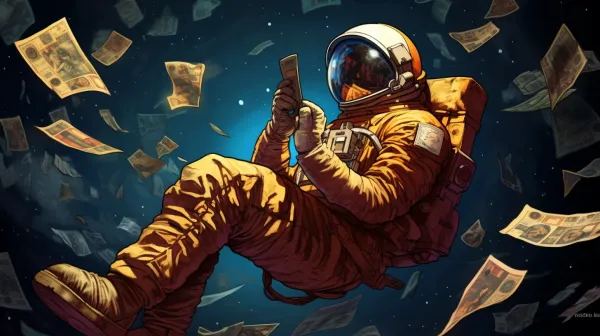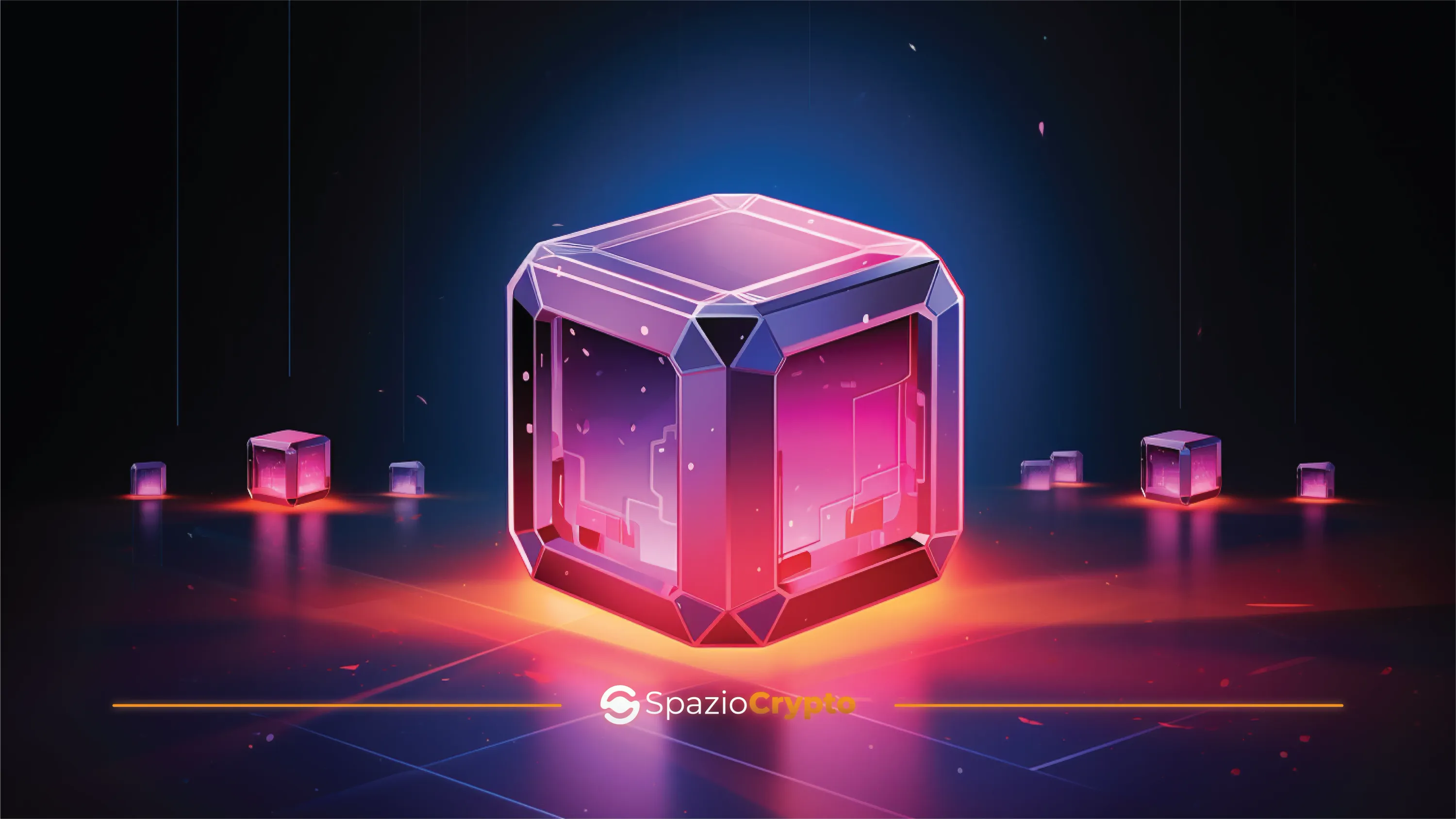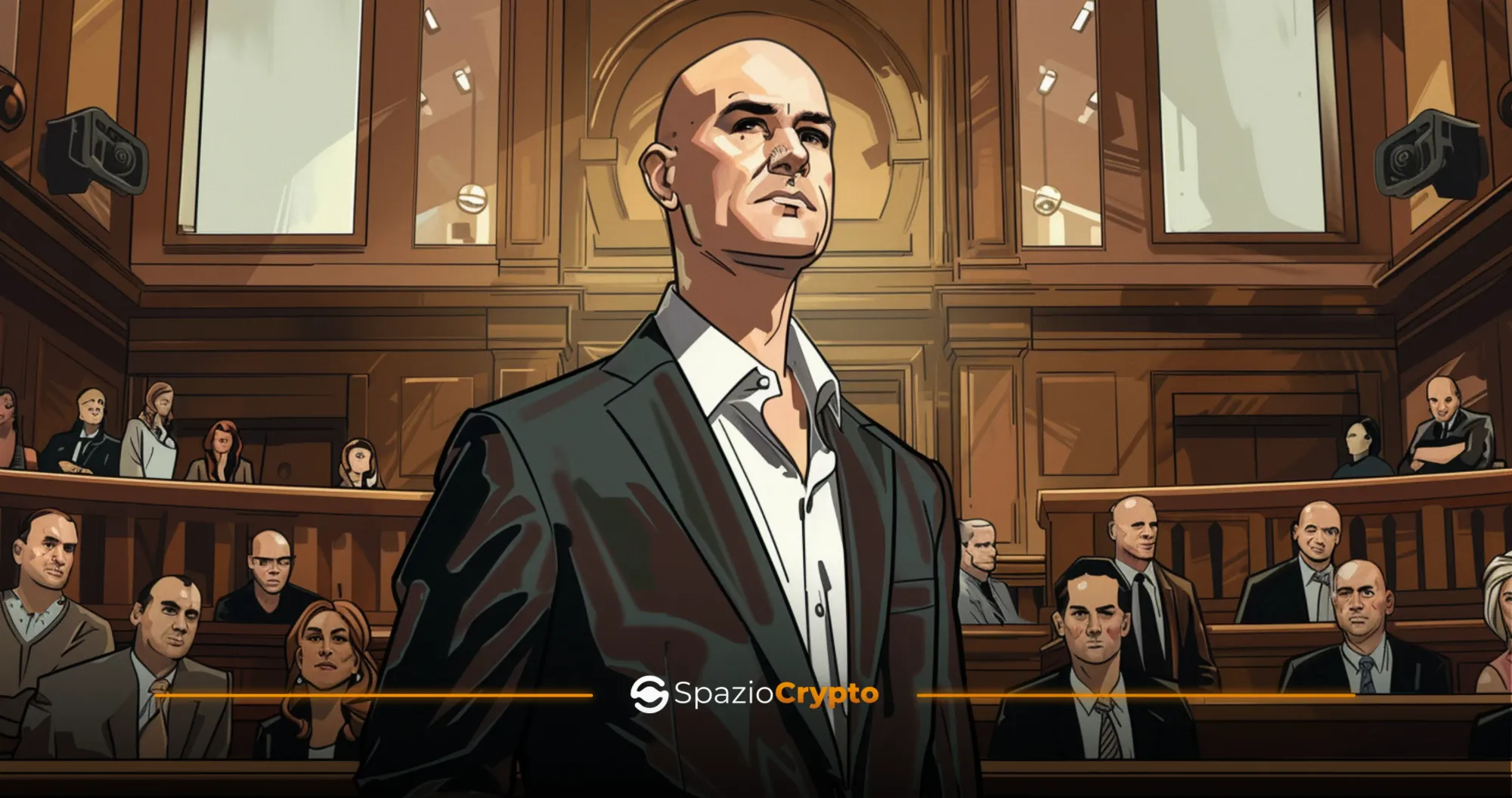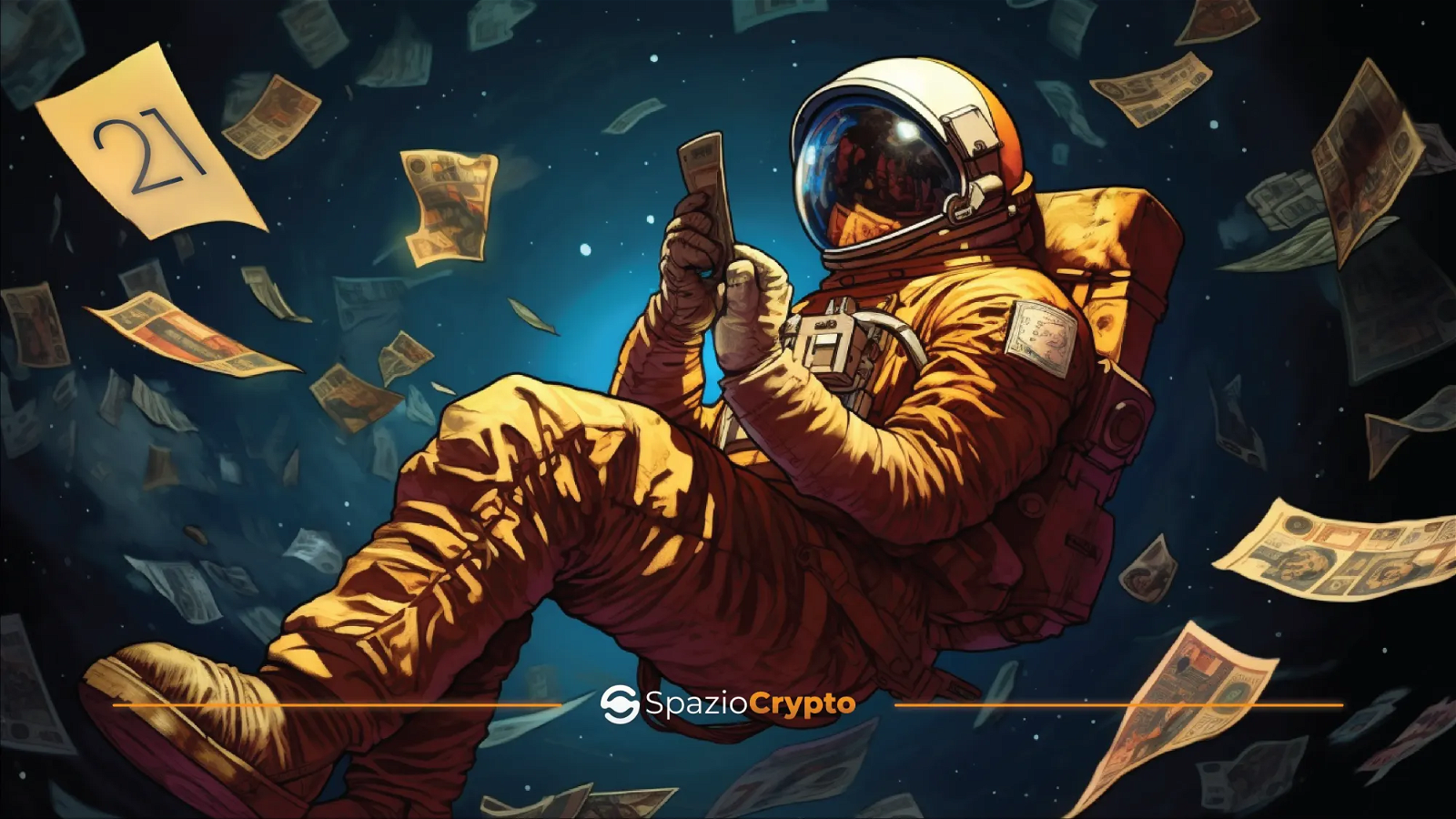NFT definition
NFTs, short for Non-Fungible Tokens, are rapidly gaining popularity in the digital and financial world. These tokens, based on blockchain technology, are revolutionising our understanding of digital ownership and distribution. But what are NFTs and why are they becoming increasingly relevant? In this article of Spaziocrypto's Web3 guide, we will address this topic by explaining all the details of this new technological innovation.
How NFTs work
NFTs represent a form of digital asset unlike any other. The word 'non-fungible' refers to the main characteristic of NFTs: they are not interchangeable with one another in an identical way, as opposed to cryptocurrencies such as Bitcoin or Ethereum, which are fungible and can be traded one for one without loss of value. To better understand this distinction, think of a dollar bill. Each dollar bill is equal and can be exchanged for another without any difference in the amount. This is a form of fungibility. NFTs, on the other hand, are unique, just like a work of art or a collector's item. Each non-fungible token has an intrinsic value derived from its uniqueness and authenticity, and this value can vary greatly from one token to another. They can represent a wide range of digital objects, including artwork, videos, music, games, video clips, and even tweets. Each time a non-fungible token is created, it is recorded on a blockchain, a kind of digital ledger that guarantees traceability and immunity from counterfeiting.
The Technology Behind NFTs
To fully understand how NFTs work, it is essential to start with the technology behind these unique tokens: the blockchain. The blockchain is a distributed digital ledger composed of securely linked blocks of data. These blocks are immutable, meaning that once data is recorded on a blockchain, it cannot be changed or deleted. This fundamental feature of the blockchain is what gives non-fungible tokens their authenticity and traceability. When an NFT is created, key information about the represented digital asset is recorded in a block on a specific blockchain. The information may include the title of the artwork, the author, the date of creation and other relevant information. In addition, the blockchain assigns a unique serial number to each NFT, conferring its uniqueness.
Creation and Registration of NFTs
The creation of an NFT is done through a process called "minting." This process involves the use of smart contracts or an NFT platform, where artists or creators can upload their digital content, define the associated information and variables, and finally create NFTs. During this process, the artist or creator can set terms of use, royalties for future sales and other specifications related to the NFT. Once the NFT has been created, it is registered on the blockchain. This registration ensures that the non-fungible token is unique and cannot be duplicated or counterfeited.
Traceability and Authenticity of NFTs
The blockchain plays a key role in the traceability and authenticity of NFTs. Every transaction related to an NFT, such as a sale or transfer of ownership, is recorded on the blockchain. This means that anyone can verify the legitimacy of an NFT by examining the blockchain, ensuring that the digital object represented is authentic and that its history is transparent. In addition, NFTs can include metadata, additional information such as digital signatures, certificates of authenticity and more, which further help to ensure the authenticity of the NFT.
Sectors Using NFTs
Digital Art and NFTs
Non-fungible tokens have had a revolutionary impact in the digital art world. Artists all over the world are using these tokens to exhibit their works and make money from them in entirely new ways. NFTs allow artists to sell their works directly to collectors via their crypto wallet, without the intermediation of art galleries or auction houses. This decentralised approach offers greater autonomy to artists and creates a more direct connection between them and their audience. But NFTs in digital art go far beyond the mere sale of artworks. They also allow creators to earn automatic royalties every time the work is resold. This royalty system is implemented via smart contracts, which automate the payment process and make it transparent and secure. For up-and-coming artists, this can be a significant source of income and an incentive to continue creating.
Games and Entertainment
The games and entertainment sector is another field in which NFTs are playing a major role. Game developers are using non-fungible tokens to create unique in-game items that players can buy, sell and trade in the marketplace. This gives players a sense of ownership over the virtual objects they acquire in games. Furthermore, blockchain games are emerging as a new category of games that are completely based on blockchain technologies, such as play-to-earn. These games allow players to truly own the game objects and have complete control over the transactions related to them.
Music and NFTs
In the world of music, NFTs are also finding application. Artists can create non-fungible tokens for albums, singles or unique music experiences. These NFTs can be purchased by fans and offer benefits such as exclusive access to special content or even the opportunity to influence the artist's decisions. This new model of fan funding and engagement is revolutionising the music industry.
Real Estate and NFTs
One of the emerging applications of NFTs is in real estate. NFTs can be used to represent the ownership of digital or even physical real estate. This opens up new possibilities for buying, selling and sharing real estate. However, this application also raises questions about property laws and regulations.
Sports and NFTs
In the world of sports, NFTs are gaining ground as a tool to sell and trade collectables related to sporting events. These can include digital trading cards of famous athletes, iconic moments in matches and more. These NFTs offer a digital collectible experience for sports fans and can also be used as a form of funding for the athletes themselves. These are just some of the sectors that are creatively adopting NFTs. In the next chapter, we will look at the potential benefits and criticisms associated with this growing technology.
Potential Benefits and Criticisms to NFTs
Potential Benefits to NFTs
NFTs bring with them a number of benefits and opportunities that are changing the way we interact with the digital world. Some of the main benefits include:
Authentic Digital Property: NFTs allow you to prove authentic ownership of a digital object, ensuring that it is original and not counterfeit. This is especially important for artists and creators who want to protect their works.
Traceability and Transparency: Transactions linked to non-fungible tokens are immutable and recorded on the blockchain, which means that anyone can verify them. This creates a high level of transparency and traceability, reducing the risk of fraud.
New business models: NFTs offer new revenue opportunities for artists, creators and developers in the Web3. Creators can receive automatic royalties from each resale, creating a continuous income stream.
Fan Involvement: NFTs allow fans to be involved in innovative ways, such as exclusive access to content or the opportunity to influence artists' creative decisions. This strengthens the bonds between creators and audiences.
Criticisms and Common Problems
However, despite the benefits, there are also criticisms and challenges related to NFTs:
Environmental Impact: The creation of NFTs on some blockchains has raised concerns about high energy consumption. Some blockchains use a significant amount of energy to validate transactions, which has triggered discussions about environmental sustainability.
Speculation and bubble: Some people see NFTs as a kind of "speculative bubble", with prices that can be extremely volatile and irrational. This volatility can pose financial risks for buyers.
Copyrights and privacy: The NFT world has raised questions about copyright management and privacy. Who owns the copyright in digital objects and how are they protected? What personal information is associated with NFTs?
Accessibility and Inclusion: Some believe that NFTs are still a relatively elitist technology and not accessible to all. This raises issues of inclusion and accessibility.
In conclusion, NFTs offer many opportunities, but also challenges. In the next chapter, we will explore the future of NFTs and how this technology might evolve over time.
The Future of NFTs
Non-fungible tokens have shown considerable potential since their emergence and their future looks promising. Here are some of the expected trends and developments for NFTs:
Expansion into new sectors: Non-fungible tokens will expand into new sectors, influencing fashion, sports, education and other fields. This will lead to greater diversification of uses and applications.
Standardisation and regulation: Standardisation and regulation efforts will help provide clearer guidance for users and investors. This could make NFTs more reliable and secure.
Sustainability: Concerns about the environmental impact of cryptocurrency mining and validation processes are prompting many blockchains to explore more sustainable solutions. This could help alleviate concerns about the ecology of non-fungible tokens.
Technological evolution: Blockchain technology is constantly evolving, and new, more efficient and scalable blockchains could emerge, making NFTs more accessible and affordable.
NFTs in the real world: Non-fungible tokens could be used to represent ownership of physical assets, such as cars or real estate. This could simplify the process of buying and selling valuable assets.
New Applications and Innovations
NFTs are inspiring innovations in various fields. For example, new social token platforms are emerging that allow users to issue their own personal tokens and build blockchain-based communities. In addition, NFTs can be used for online voting and polling, ensuring the transparency and integrity of decision-making processes. In the field of art, we see collaborative virtual artworks in which several artists contribute to a single work, with each owning a part of the work in the form of NFTs. These new forms of collaboration are revolutionising the way art is created and shared.
Tips for Investing in NFT
If you are interested in investing in NFT, it is important to proceed with caution. Consider these tips:
DYOR: Do your research: Before investing, try to fully understand the NFT or collection you are interested in. Assess its authenticity and long-term value.
Diversify: Don't put all your eggs in one basket. Diversify your NFT portfolio to reduce risk.
Consider the community aspect: Communities of enthusiasts can influence the value of an NFT. Consider the community surrounding the NFT or the platform on which you purchase it.
Keep an eye on the market: The NFT market is volatile. Monitor trends and changes in value.
Conclusions and Perspectives
At Spaziocrypto, we believe that NFTs are changing the way we interact with the digital world, offering new opportunities and challenges. Their future is promising, but will require a balance between innovation and regulation to ensure sustainable growth. Technology continues to evolve, opening up new avenues for the use of NFTs, and only time will tell what their lasting impact will be in our digital society.








